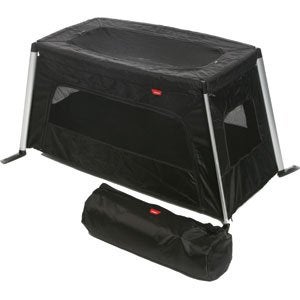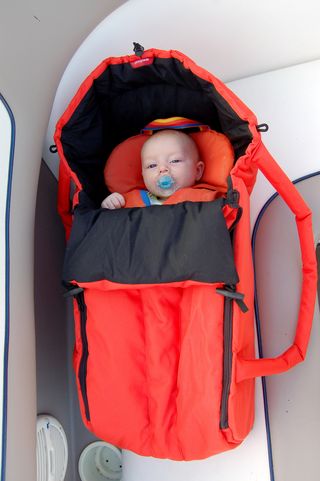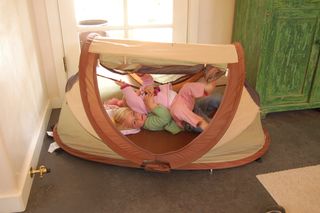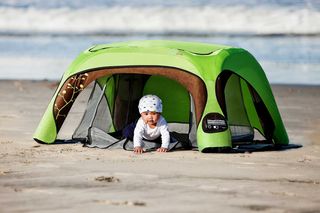When it comes to outdoor gear, few items are as seductive and covetous as….backcountry cribs. OK, maybe you’d rather be fantasizing about the newest, sleekest 29er mountain bike or a flyweight backpacking tent, but chances are if you’re reading this, you’ve got more pressing priorities on your plate. Such as: how to get the kid to sleep through the night in the wilderness so you can, too.��
There’s nothing light about this classic stand-by, but we schlepped down the San Juan River for six days anyway because our two-and-a-half year old has been sleeping in one since she was an infant, and to venture out into a remote canyon for six days without it would be akin to forgetting the stash of emergency pacifiers: really living on the edge. This is the burliest of the bunch, able to withstand a serious backcountry beating if you can stomach its size and weight. Our top choice when weight isn’t an issue but durability is.
Pros: With a super-easy push-button folding, you can set it up or break it down in less time than it takes your husband to change the baby’s diaper. It’s sturdy, with a rigid yet comfy mat that elevates the baby off the ground and won’t deflate if you accidentally put it on top of a cactus. It conveniently doubles as a playpen when you get to camp and need to corral the kid—no-brainer safety is a beautiful thing (especially if it allows you to actually sit down for a few minutes and swig a beer).��
Cons: Way heavy, at 20+ pounds, and big: 28” x 40”. Taking one into the backcountry might tarnish your hard-core cred: This thing looks more at home in grandma’s guest room than in a desert canyon, but what the hey. No one said having kids would make you cool. So jumbo you'll probably need a bigger tent (our two-bedroom����is almost huge enough for bunk beds).��
Deets:models starting at $69,��.
��
Our littlest river baby, Maisy, slept as advertised on the San Juan in this super-light, ultra-packable crib from nifty New Zealand gear whiz Phil & Teds. We liked it right off the bat for its slim profile—the rugged nylon-and-mesh crib packs discreetly into a black bag about the size of a lightweight backpacking tent that doesn’t scream Baby on Board! Were it not for some minor assembly glitches, this would have been our hands-down favorite of the bunch. Light, small and stylish.

Pros: At just 7 pounds (not including the thermal-insulated mattress) and 23 inches long when folded, it’s small enough to fit into the overhead compartment and you won’t break your back doing it. Their clever motto says it all: It weighs less than the baby, yet it was plenty roomy for our 11-month old, with inches to spare. The zippered top keeps mosquitoes out and climbers in, and the mesh, zip side panel converts the cot to a play space (though our girl’s already standing and wanted out as soon as she woke up). The self-inflating mattress, alpine-tested and as bomber as Daddy’s Thermarest, slides neatly into a zippered panel on the floor and rests right on the ground.��
Cons: Fussy assembly. A typo in the manual had us momentarily confused, but luckily assembly is pretty intuitive so we figured it out. But the aluminum frame legs were hard to attach and even harder to detach: It took two of us and some serious muscle power to yank them apart each morning when we broke camp. Hopefully this was a one-off problem. ��
$180; www.philandteds.com
��
Designed for newborns to six months old, this soft-sided baby carry cot was the bomb when Maisy was an infant. We originally purchased it when she was a month old and we were at my parents’ island cottage and needed something to put her in when we went out in the boat. Even swaddled in her , she could stretch out on her back in the Cocoon; we soon started using it at night, too, and she’d fall asleep in the kitchen and later we’d sling the cot over one arm and carry her undisturbed to her room. Baby in a bag!

Pros: I’m a sucker for functional, cool-but-not-cutesy design, and like the rest of the Phil & Teds line, the Cocoon doesn’t disappoint. A cross between a canvas tote bag and a traditional cradle board, the Cocoon is a cozy nest with padded base soft enough for snoozing yet stiff enough to prevent shaken-baby-syndrome when the boat went over waves. The full-length zippered cover comes with toggles, so you can unfold it up to the baby’s neck to keep her warm or peel back in hotter weather, and the long, soft handles are generous enough to fit over your shoulder. (Even six-foot Steve could sling her like a suitcase.) At 2.7 pounds, it smooshs easily into your duffle and is as light as the price.
Cons: When she was two months old, we turned the Cocoon into Maisy’s whitewater bed on her debut run down the Rio Chama north of Santa Fe. Just as we had at Stony Lake, we put her in her PFD, laid her on her back, and put her on the raft. Ships ahoy! But as the blazing New Mexico sun beat down on us, we found ourselves wishing the Cocoon came rigged with a detachable sun shade. We improvised by draping the sun shade from her car seat over top, making sure we could reach in and grab the safety loop on her lifejacket if we needed to. A minor complaint for a versatile nest for your littlest chick.��
Deets: ; $59.

More a tiny kiddy tent than a travel bed, the flyweight Pea Pod arrived a few weeks before our San Juan trip and our toddler immediately went to work putting her “babies” to bed inside. She didn’t balk at being zipped in, and even insisted on snoozing in the Pea Pod during one afternoon nap—a major milestone for our crib-obsessed kid. But that was short-lived and the Pod became more of a novelty playpen than a serious place to get some zzzs. We brought it down the San Juan anyway, thinking it’d provide kid-sized shade in a pinch—and it did—but the nights were so sultry, we sidelined it for sleeping: It was far too hot to put her in a tent inside a tent.
Pros: By far the easiest, fastest assembly of all. Just unzip the round carrying pouch and presto! The two-hoop tent pops out, fully-formed, like a Jack-in-the-Box. (Beware of tiny bodies in the immediate vicinity—this thing has some serious spring.) The rubber mattress inflates easily with the plastic hand pump and then slides into the compartment on the bottom, resting directly on the ground. UV protection on the roof save sensitive skin from the sun, mesh window panels keep the kid from feeling cut off, and the nylon fly zips over for darkness and privacy. At 4.75 pounds, light and uber-stowable yet large enough to fit kids up to age six. ��
Cons: A week in the desert proved too prickly for the flimsy rubber mattress, and ours came home from the river with a small tear. Duct tape sealed the leak, but a patch kid would have been nice. Taco-ing back into the bag takes some practice and deft wrist work.��
Deets: $85,��.

This one arrived too late and missed the boat for our raft trip, but we’ve been testing it on adventures here and there ever since, and love the way an entire crib mashes into an old-fashioned rucksack. Inspired by kiteboarding kites to be sturdy and rigid when in use, and small and packable when stowed, the Go Crib doesn’t just have an inflatable mattress: The whole crib inflates. Four soft, curved legs contain independent air chambers that pop up into standing position when filled with air.

Pros: What’s not to love about a bed in a backpack? Set-up was straightforward: Simply fill the valves with air to erect the crib. The dual-action pump attaches easily and removes cleanly without annoying air leakage, and disassembly is just as easy: Open the valves and press and hold the red button until the crib deflates. The baby can go in through the open top, or unzip the front panel for ground-floor access. The whole kit, including pump and mattress, weighs a mere 11 pounds—shockingly light for such a sturdy crib. Attachable mosquito net and rain fly (not included) make this wilderness-ready. ��
Con: There’s no separate envelope for the insulated mattress pad—you just put it on the bottom of the crib, which made me a little nervous about tiny chewers gnawing at the valve. The thick, suede-like outer layer on the legs and sidewalls is designed to protect the air chambers from thorns and cactus spines, but I’d still think twice about bringing this on an extended backcountry trip with no backup. The small plastic pump attaches neatly to the valves, but it’s light almost to a fault: I got super sweaty trying to keep it from flopping around. And the backpack packs pretty fat: No wiggling through narrow slots or crowded NYC subways with this baby. ��
Deets: $249,
��